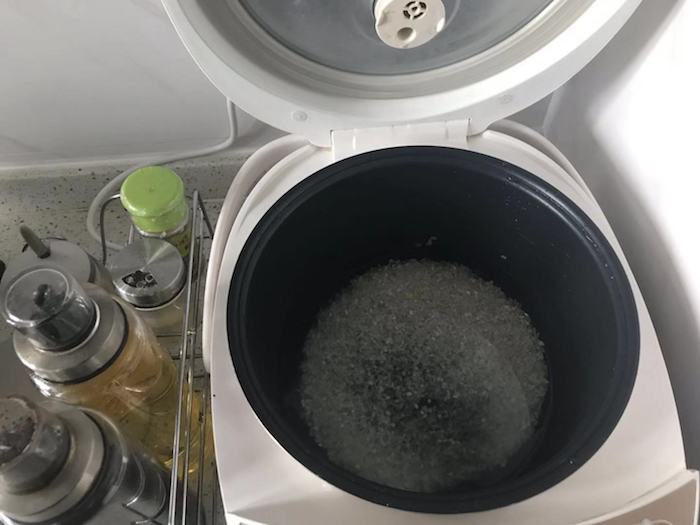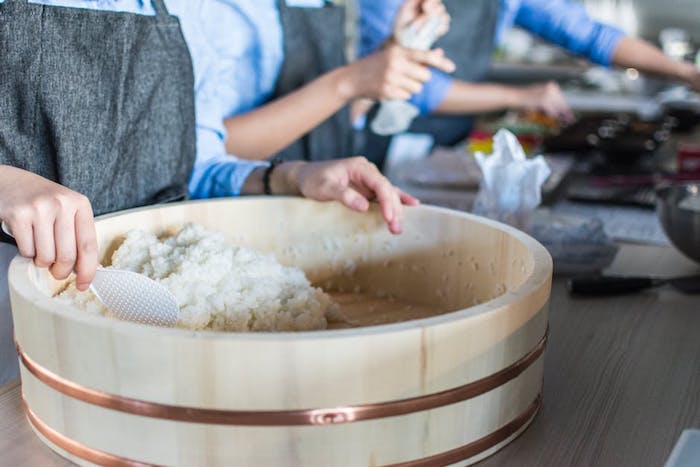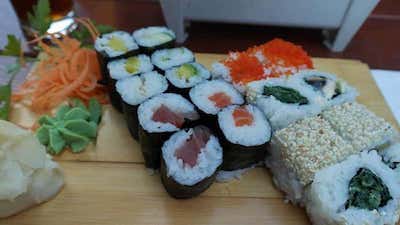We are reader supported. When you purchase through links on our site, we may earn an affiliate commission. Also, as an Amazon affiliate, we earn from qualifying purchases.

Sushi is a very popular meal these days! It began as a take-out food in Japan in the 1800’s and is now enjoyed by people of all nationalities. In fact, its popularity has grown so significantly that the word ‘sushi’ is recognized almost anywhere in the world!
Sushi is made with simple ingredients such as raw fish, vegetables, seaweed or ‘nori’ and cooked rice. It is the quality of the rice that will often ‘make-or-break’ a good sushi roll! The temperature of the rice is crucial, which begs the question, “does rice need to be cold to make sushi?”
Does rice need to be cold to make sushi? The ‘perfect’ sushi rice is neither hot nor cold! It should be cool, preferably at room temperature. Warm rice should never be used for sushi.
Now that you know the right temperature for sushi rice, let’s explore in more detail how to properly cook, cool and season the ‘perfect’ sushi rice! We will also discuss which type of rice is best and which ones you should definitely avoid. So, if you are ready to learn all you need to know about preparing the ‘perfect’ sushi rice, then let’s get started!
Do You Make Sushi with Hot or Cold Rice?
The key to good sushi is the rice! It must be of a certain grain(see my favorite short grain rice), consistency and temperature in order to make the ‘perfect’ sushi roll. Sushi chefs will often recommend using cool (as opposed to cold) rice or ‘shari’ that is at room temperature, which is around twenty-two degrees Celsius or seventy degrees Fahrenheit.
Warm rice does not make good sushi and should never be used. If it is warm, the rice will not balance the flavours and textures of the ‘neta’ or other sushi ingredients. This is especially true with the cold, raw fish that is often used. On the other hand, cold rice is not recommended by chefs either. If it is cold, the rice will taste overly salty and lose its vinegary flavour.
Which Rice is Best for Sushi?
The best rice for sushi is white, short-grain Japanese rice (such as Oumimai or Japonica) or medium-grain California rice (such as Nishiki). In North America, these types of rice are often labeled as ‘sushi rice’ or Calrose rice. Oumimai, Japonica and Nishiki are all available online with the added benefit of being shipped right to your front door! You can have a look at my previous article which has listed my favorite 10 sushi brand.
Do not use long-grain rice, such as Basmati or Jasmine, as these tend to have a dryer, fluffier texture and do not ‘stick’ together well. Arborio rice, often used for making risotto, is not a good choice for sushi either as its texture is often too firm.
Brown rice is sometimes used for sushi, more so in the East than in the West. It contains more fiber than white rice and as a result, is heavier and firmer. This is not ideal for authentic-style sushi as it has an ‘earthy’ taste that overpowers the delicate flavors of the fish and other ingredients used.
For more: Can You Make Sushi with Brown Rice?
How to Cook Sushi Rice?

It is very important to properly prepare rice for sushi-making. You don’t need anything fancy, a simple pot or rice cooker will do! For your convenience, I have included my easy-to-follow link here. For learning how to make sushi rice in a rice cooker or pot.
How to Make the Perfect Sushi Rice
Once you have cooked the rice, there are a few necessary steps needed to make the perfect sushi! These include the following:
- Removing the rice. After the rice is cooked, it very important to take it out of the pot or rice cooker carefully. It is recommended to use a wooden spoon instead of a metal one as the metal can damage the rice and possibly react with the vinegar (to be added later). Also, do not scrape the rice stuck to the bottom of the pot. It is too dry and not of good sushi-making consistency.
- Seasoning the rice. In order for the rice to taste like sushi rice, it must have rice vinegar added to it after it is cooked. To do this, add ½ cup of rice vinegar, two tablespoons of sugar and two teaspoons of sea salt to three cups of rice. Mix the vinegar, sugar and salt in a pot over medium heat until the solids are dissolved. Pour the mixture over the cooked rice and mix well. Set the rice aside and allow it to cool down.
- Allowing the rice to cool. Perfect sushi rice should not be warm. Allow it to cool down to room temperature by either fanning it or simply letting it sit (covered) on the counter to cool naturally (if you have the time). Do not cool it in the fridge as this will negatively affect both the taste and texture of the rice.
- Preparing the ingredients (‘neta’). While the rice is cooling down to room temperature, use the time to prepare your sushi ingredients. Cut the fish and vegetables, get the seaweed wraps ready, set aside the soy sauce, wasabi and pickled ginger, etc. This is likely to take around ten to twenty minutes. You can have a look at my previous article 30 good ides for sushi roll fillings
- Making sushi. Once the rice has reached its perfect sushi temperature (cool, not warm), begin to make your sushi. Put any remaining rice into the fridge until further needed. You can use this left-over rice to prepare your next meal as long as it is consumed within five days (two to three is preferable).

What is the Best Way to Cool Sushi Rice?
Allowing sushi rice to cool down to room temperature can be time-consuming. One way to speed-up the process is to place a clean, cool, damp (not wet) tea towel on the counter and ‘fold’ the rice on top of it in front of a low-running fan. Another way to cool down the rice is to spread it across a baking pan and then cover it with a damp kitchen towel to prevent the rice from drying out.
It is not recommended to put cooked sushi rice into the fridge to cool it faster as this will affect the rice consistency. It is better to prepare the rice earlier on and allow it cool naturally, if possible. This may take more time than fanning but is ultimately the best (and easiest) way to cool sushi rice.
It is okay to make the rice up to six hours in advance (which is plenty of time to cool down to room temperature), just be sure to cover it. Once the rice is in the bowl, place a damp cloth over the top, pressing lightly against the rice. This helps the rice stick together better while keeping the top layer from drying out.
Sushi chefs will often use a small wooden container made from Japanese cypress called an ‘ohitsu’ to control the temperature of the rice. It not only keeps the rice at the perfect cool temperature but also helps to absorb excess moisture, preserving the rice. It is usually covered with a cloth or wooden lid and if further insulation is needed, it is placed in a woven straw container or a ‘warabistu’.
Can You Put Sushi Rice in the Fridge?
As mentioned earlier in this article, it is okay to put cooled (never warm) sushi rice into the fridge for future use. Be sure the temperature is around five degrees Celsius (or forty-one degrees Fahrenheit). The rice should be covered and used within two days for optimum freshness. It will last, however, up to five days in the fridge, if properly stored.
Leftover sushi rice can be used for a variety of things including soups, risotto, fried rice and ‘mochi’ or Japanese rice cakes. ‘Mochi’ is made with short-grain Japonica rice, water, sugar and cornstarch. The rice is pounded into a paste and then molded into the desired shape.
For more: 11 Ways To Use Leftover Rice(not sushi rice)
Conclusion
Preparing the perfect rice is essential to making authentic, delicious sushi. It must be properly cooked, cooled and seasoned in order to be sushi-worthy! The best sushi rice is neither hot nor cold. It is cool, preferably at room temperature. Do not put warm sushi rice into the fridge to cool down as this will negatively affect both its taste and texture. Rather, ‘fan’ the rice or allow it to cool naturally.
Warm rice should never be used to make sushi. It does not work well with the cold, raw fish nor will it compliment the flavors and textures of the other sushi ingredients or ‘neta’. Now, you know how to better prepare your next sushi role, made with the ‘perfect’ sushi rice. Good luck and ‘bon apetit’ (‘Itadakimasu’, in Japanese)!


Comments
How do I refresh sushi rice the next day to make more rolls,,,?